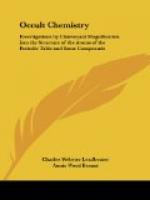When the proto-compounds are dissociated, the funnel-sphere sets free: (1) the contents of a, rearranged into two groups of four within a common sphere; the sphere yields four duads as hyper-compounds; (2) the contents of b, which unite themselves into a quartet, yielding two duads as hyper-compounds; and (3) the contents of the two spheres, c, which maintain their separation as meta-compounds, and become entirely independent, the atoms within the sphere revolving round each other, but the spheres ceasing their revolution round a common axis, and going off in different directions. The atoms break off from each other, and gyrate in independent solitude as hyper-"compounds.” Thus each funnel yields finally ten hyper-bodies.
The part of the central globe, marked d, with its six atoms, whirling round a common centre, becomes two triplets, at the meta-stage, preparing for the complete separation of these as hyper-bodies. The second part of the same globe, marked e, a whirling cross, with an atom at each point, becomes a quartet in the meta-state, in which three atoms revolve round a fourth, and in the hyper-state this central atom is set free, leaving a triplet and a unit.
Each of the two bodies marked f, liberated from the connecting rod, shows four atoms whirling round a common centre, exactly resembling e in appearance; but there must be some difference of inner relations, for, in the meta-state, they re-arrange themselves as two pairs, and divide into two as hyper-bodies.
The body marked g is a four-sided pyramid, with two closely joined atoms at its apex; these still cling to each in mutual revolution as a meta-body, encircled by a ring of four, and this leads to a further dissociation into three pairs on the hyper-level.
CHLORINE (Plate V, 2).
[Illustration]
The description of the funnel of sodium applies to that of chlorine, until we come to the body nearest the mouth, the sphere containing three additional bodies; this remains within the funnel in the first dissociation, so that again we have twenty-four separate funnels as proto-compounds; the central globes are the same as in sodium, and yield the same four bodies; the connecting rod sets free five bodies, of which two are the same; we have thus thirty-three separate bodies as the result of the dissociation of chlorine into its proto-compounds. As all the compounds which are in sodium break up in the same way into meta- and hyper-compounds, we need not repeat the process here. We have only to consider the new meta- and hyper-compounds of the highest sphere within the funnel, and the two triplets and one quintet from the connecting rod.
The additional body within the proto-funnel is of a very simple character, three contained triangles within the flattened sphere. On release from the funnel, on the meta-level, the atoms rearrange themselves in a whirling set of three triplets, and these break off from each other as hyper-compounds. The two triplets from the connecting rod, also, are of the simplest character and need not delay us. The five-atomed body, a four-sided pyramid as a proto-compound, becomes a ring whirling round a centre on the meta, and two pairs with a unit on the hyper.




